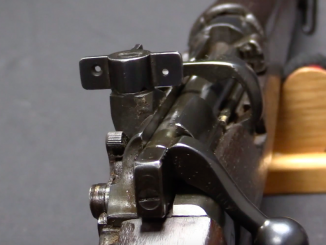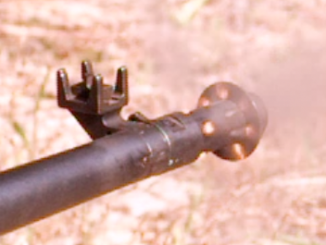The Vickers-Berthier was initially designed by Andre Berthier in France prior to World War One. It went through a number of substantial design changes before the war, and was actually ordered in quantity by the United States right at the end of WWI – but the order was cancelled with the armistice. In the 1920s, Berthier sold the design to the Vickers company in England, which wanted a light machine gun to market alongside its Vickers heavy machine gun.
When the British military decided to replace its Lewis and Hotchkiss light machine guns, the Vickers-Berthier was one of the leading contenders, although in the endurance trials it was edged out by the Czech ZB-33, which would ultimately be adopted as the Bren. However, the Indian Army opted to take the Vickers-Berthier, and it was put into production at the Ishapore Rifle Factory and saw substantial use in World War Two.
Mechanically, the Vickers-Berthier is a tilting bolt design with a long stroke gas piston. It has a thorough set of covers over the magazine well and ejection port, and a relatively slow rate of fire. The barrel is quick-changeable, and it feeds from top-mounted 30-round magazines, with an aperture type rear sight being offset to the left side of the gun to clear the magazine.
Thanks to Marstar for letting me examine and shoot their Vickers-Berthier!




With a few modifications the Vickers Berthier becomes the Vickers K, complete with high capacity pan magazine, aircraft gunner grip, and an insanely high cyclic rate of fire coming close to that of the MG-42. I don’t know if the Bren could do that. Any ideas?
Bren and its preceding models were apparently not capable of that feat. For purpose of arming pre-war Csl. airforce was used recoil operated machinegun with rate of fire up to 1000 rpm. It was ether large-capacity drum magazine or belt-fed.
http://forum.valka.cz/topic/view/15843
Its prime use was on observation aircraft as well as fighter planes (4 units mounted on Avia B534). It was later used by Wehrmacht in ground role.
Additional photos of vz. 30 machine gun:
http://www.airwar.ru/weapon/guns/czk30.html
Good stuff Daweo
I was checking that picture of vz.30 in dis-assembled state and it seem to me that there is no close resemblance with Browning 1919. Also, the plane which is mentioned there as Avia B71 was basically license built Tupolev SB, only truly modern bomber in Csl. aviation inventory.
https://en.wikipedia.org/wiki/Tupolev_SB
According to linked article vz. 30 was derived from vz. 28 machine gun, which itself was licensed aircraft export variant of Maxim-Vickers machine gun. Main difference between vz. 28 and vz. 30 was feed system, which now can accept belt or 50-round magazine. German designation for this weapon was MG 30(t).
“For purpose of arming pre-war Csl. airforce was used recoil operated machinegun with rate of fire up to 1000 rpm”
Václav Holek was also working on externally powered machine gun, called ZB.80 which fired 7,9×57 cartridge:
http://www.airwar.ru/weapon/guns/zb80.html
it was supposed to be powered from aircraft engine (not new idea back then, Gebauer machine gun is example tested yet in 1918 year in Hungary), however one of specific traits of ZB 80 was that its Rate-of-Fire-to-engine-RPM was not constant, it was achieved by building device similar to automotive gearbox. Other specific feature was that rather than ramming cartridge into chamber, whole barrel was moved against cartridge (like in blow-back designs), moreover was never removed from belt of peculiar construction (examine 2nd photo from top in link). Maximal rate-of-fire was 1200 rpm. It is said improved version was planned which would use variator instead of gearbox, but it wasn’t created until Germans took control.
is: “(…)moreover was never(…)”
should be: “(…)moreover cartridge was never removed from belt(…)[during weapons function]”
To hook up machinegun on engine revolutions seem at first as “nuts”, but in second look it makes sense – in fact, is it not same as synchronisation? Rate of fire variation may not be of such concern, my guess.
“same as synchronisation”
Not.
Synchronous machine gun is powered by powder gases from firing cartridge, in case of cartridge activating failure (“dud” cartridge) it will stop cycling.
Externally powered machine gun is immune to “dud” cartridge, however it can’t work when engine is out of order.
I meant in effect. I recognize that the powered and self-powered guns operate differently. But it seem to me as advantage if you can do away with synchronizer.
I read recently that to avoid effect of duds in self-powered guns such as Gryazev-Shipunov twin cannons they use blanks to emergency restart them.
“blank”
Name for reloading blank is пиропатрон, for twin GSh пиропатрон ППЛ is used, see 1st image from top here:
https://reibert.info/threads/piropatron-ppl.177214/
ППЛ is also used for other weapons reloading (НР-30, 2А42, 2А72), it is more compact and less complicate that pneumatic one.
It also used in bombers for opening bomb holders (letting bombs to fall under gravitation).
ППЛ is 6,18×60R cartridge with electric primer loaded with 3,5 g of powder (pyroxylin).
I wonder why the MG was driven mechanically by the engine rather than by an electric motor. Perhaps insufficient generator power or a electric motor was considered too heavy?
“electric motor”
What with synchronization in this case?
If machine gun is mechanically linked it is clear that it is synchronized, in case of electric power I am not sure.
Here are more pictures with vz.30; completely different then Bren:
https://forum.axishistory.com//viewtopic.php?f=49&t=87121
Ah, cannot hold back to be ‘first responder’. This gun has been a curiosity for me for long time and now we have the fortune that Ian put some light on it. It surely is intriguing and its features indicate variety of input in time. From time of its conception it should be clear that it preceded Brno machineguns, although they had their predecessor in Praga prototypes which go back to 1919. So be it, if two (or three) are doing ‘the same’ it does not mean it is the same as existence of Chatellerault gun confirms.
When comes to Marstar this is the right place to go and frankly it amazes me how they manage to be in this kind of business in this gun-restrictive environment. They have my respect and admiration.
When you said the grip is reminiscent of a revolver, I was already thinking the curve and shape of the trigger guard reminded me of a Webley revolver.
Any idea (or is this better a Q&A question) why top feeding LMGs fell from favor? Things like the Stoner and Minimi accepted rifle mags at an angle, if I remember. Seems a good way to get prone without a big banana magazine sticking in the dirt (like an RPK).
“why top feeding LMGs fell from favor”
I would say that it might be cause by another approach to various sights today.
Back in 1930s LMG were equipped just with mechanical sights, no-one required it to be able to swap it for some others or so, today various rails (for example MIL-STD-1913) are seems as default and allow fast swap of sighting device.
LMG with magazine sticking upward can’t have sights installed on top of it (would be useless as you would see just your magazine instead of sights).
It is technically possible to use side-mounted rail, however it would need additional fiddling to make it yielding to actual point of impact of bullet or some clever rail-sight system to make sight self-adjusting.
In case of 1930s technology (and any sight installed once and forever) this was not special issue as it could be done by factory and once was enough.
It may be kind of silly to tell your enemy…. this is where to shoot and your own – do not shoot at me. I may be wrong but looking at recently discussed QBZ rifle, from time when I saw it first my thought was: with that dog leg front sight it surely cannot be confused for M16. Maybe there is a purpose behind it.
“Maybe there is a purpose behind it.”
I doubt in it, notice that during World War II, captured weapons were frequently used, like for example PPSh by German forces.
Top feed LMGs fell out of favour because they were replaced by belt fed GPMGs which gave you more firepower and more flexibility as to how you use them. It’s also easier to carry belts of link than magazines.
Prior to that though, nearly everybody had a top feed LMG. Ones which weren’t top fed were in fact rather rare.
The few magazine fed models you see today though are nearly always derived from assault rifles, which means they have to have a bottom magazine.
It also has a strong resemblance to the North Korean Type 73. Although the NK gun is supposedly based upon Soviet PK designs with some Czech ZB influence, overall it looks somewhat more like the Vickers-Berthier’s. Maybe just a coincidence, but worth a mention.
http://www.thefirearmblog.com/blog/2016/09/21/potd-north-korean-type-73-lmg/
This at first glance looks like crude made gun used for magazine feed only. At the same time use of rivets is preferable over welds (such as we see on Minimi). I first thought that gate on RH side is belt inlet, but cannot tell for sure. In that case the ejection would be downward, which is very likely.
If it was influenced by vz.52 it would be likely belt and magazine fed. Interestingly though, NK is said to export small arms, presumably clandestinely with respect to current restrictions.
The GRI on the receiver doesn’t identify it as being made in Ishapore. It represents who it was made for George Rex Imperator, George, King and Emperor (of India). In this case George VI. Post Indian independence weapons are marked RFI for Rifle Factory Ishapore.
Vickers LMG was used by Spanish navy and Marine Corps.
Von Lossnitzer alert ! Mobray has restocked.
Just received my copy today.
You may want to notify the several disappointed readers of your book review who mentioned they tried to buy the book and could not.
Now waiting for my copy of Collector Grade’s Sturmgewher.
Man, you’re getting expensive.
My Father flew a Beaufighter in WW2 and that had a Vickers K in the read observers position. My Father used to say his Navigator used to shoot it at the ships as they flew Torpedo runs. He called it a “pop gun”. I guess compared to a torpedo and 4x20mm and 4x 303s brownings up front it was.
This good examples of process known as моральное старение in Russian (literary: moral aging) and it affects all devices, it mean that device become less and less effective due to development in area influencing its effectiveness. Not to be confused with mechanical wearing down. In this case (rifle-caliber aircraft machine-gun) lowering its effectiveness was caused by introduction of all-metal aeroplanes with self-sealing fuel tanks.
http://www.ngpedia.ru/id478420p1.html
The only problem with dismissing rifle caliber machine guns as useless against aircraft is if the cockpit canopy is not bulletproof by any means. A P-51 got shot down by a Fieseler Fi-167 before the latter (a biplane torpedo-bomber, by the way) was mercilessly ripped to shreds by the former’s squadron. In fact at least one jet fighter was lost to a Polikarpov Po-2…
The CSRG Chauchat fusil mitrailleur book _Honour Bound_ has some good info about Berthier’s design and the simplicity of it… Albeit not in 8x50mmR Lebel cartridges, what with the extreme “double taper” necessitating a very curved box magazine… Interesting to see it used by British Dominions/colonies. It was also heavier than the Bren gun/VZ33 prototype, yes?
photograph of Vickers-Berthier in Afghanistan.
https://cdn01.dailycaller.com/wp-content/uploads/2018/11/Taliban-Militants-e1541516687999.jpg
https://politics-history.mozello.com/page-8/params/post/1714431/